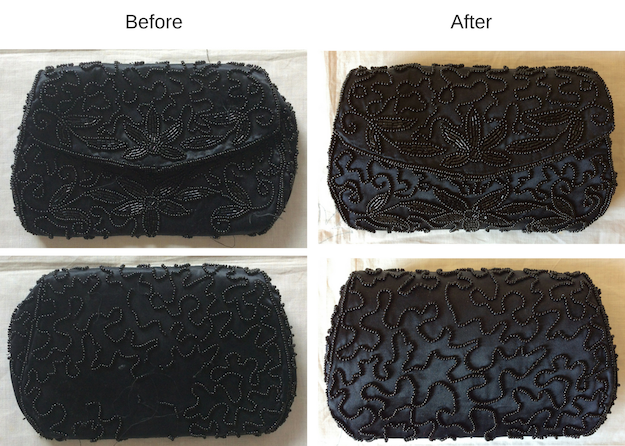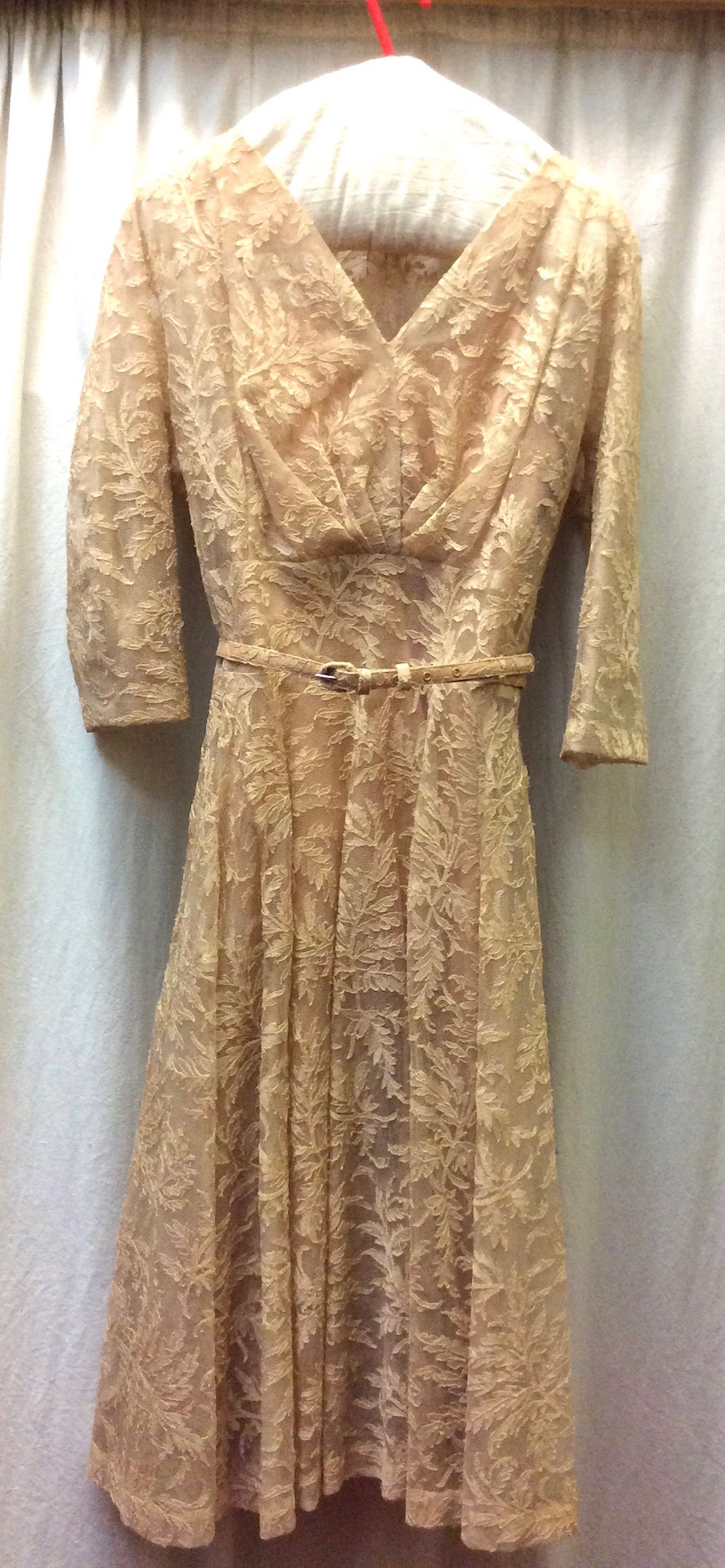About Clothe 22
From our very early beginnings we have clothed and adorned ourselves. Across cultures, countries and climates we use clothing to protect ourselves, communicate our culture and identity, and evolve who we are, reflecting our innate selves. At Clothe we believe in a world that celebrates diversity and authenticity. We advocate for the preservation, Read More
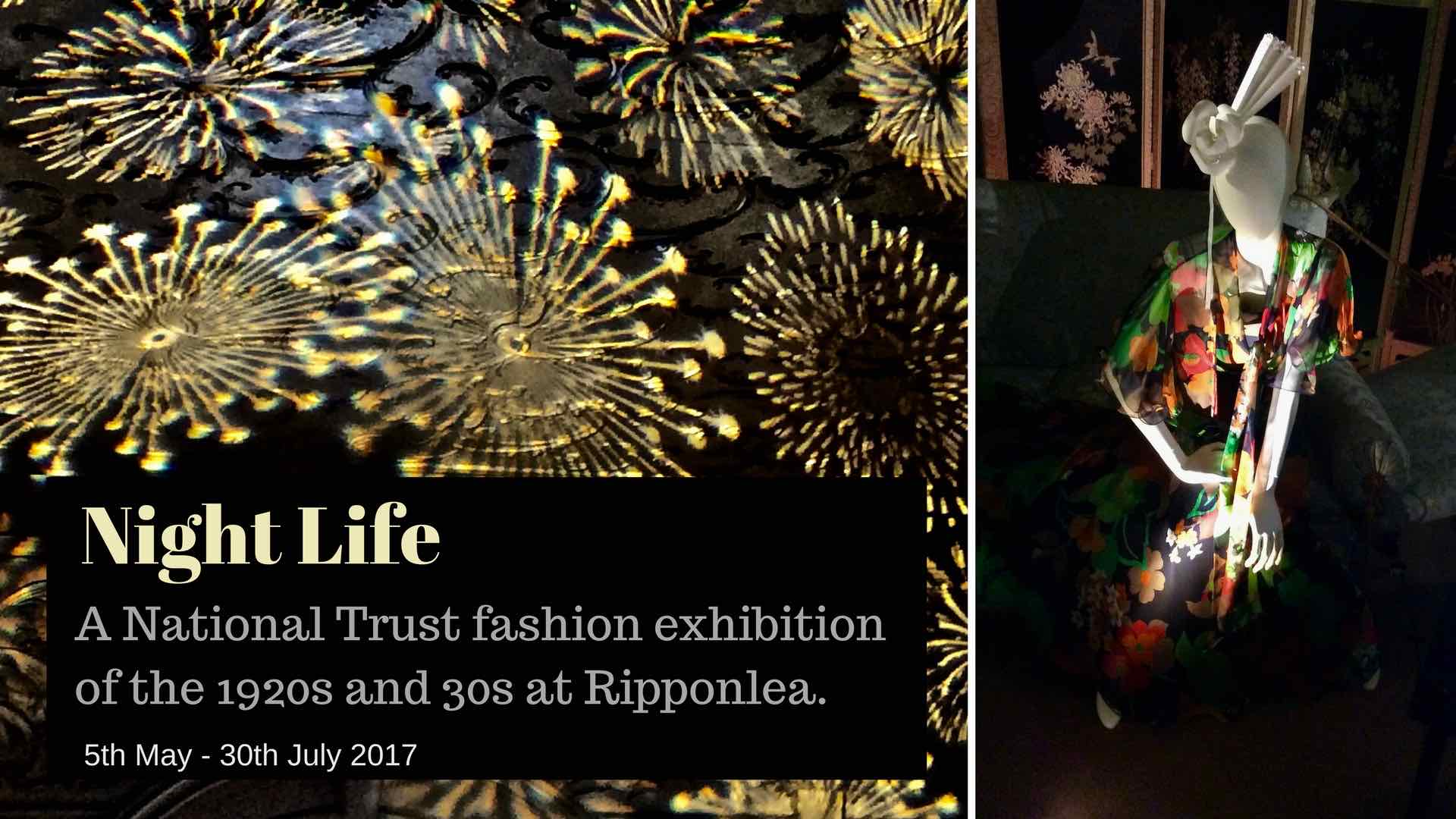 Ripponlea and Barwon Park have hosted some stunning frocks in their time. This new exhibition by The National Trust, Night Life – A fashion exhibition of the 1920’s and 1930’s is no exception. A recent bequest of gowns inspired this curation exploring the decadent, ground breaking, jubilant styles of the 1920s and the more sober, practical conservatism of the 1930’s. The post war and interwar periods saw an enormous amount of change in social customs and economic conditions, and clothing is always an incredible barometer of the whole picture of society at a certain place and time.
Ripponlea and Barwon Park have hosted some stunning frocks in their time. This new exhibition by The National Trust, Night Life – A fashion exhibition of the 1920’s and 1930’s is no exception. A recent bequest of gowns inspired this curation exploring the decadent, ground breaking, jubilant styles of the 1920s and the more sober, practical conservatism of the 1930’s. The post war and interwar periods saw an enormous amount of change in social customs and economic conditions, and clothing is always an incredible barometer of the whole picture of society at a certain place and time.
Many early 1920’s evening dress features amazing, intricate beadwork with new and exotic materials such as celluloid and gelatine. Celluloid sequins offered the clothed experience a luminosity, sparkle and sound that reflected well the excitement, excess and prosperity of the time. Some dresses featured approximately 2 kg of embellishment carefully stitched to feather light silks and cotton tulle. With the thrashing of exuberant jazz dance moves such as the Charleston in hot sweaty smoky nightclubs it is no wonder that many dresses have not withstood the test of time. It is a joy and a pleasure to be able to see such well preserved precious examples as these.
As we moved into the 1930’s with the occurrence of The Great Depression and Wall street crash of 1929 as well as ominous political events in Europe, sequins, and beads were abandoned in favour of printed, painted and more restrained styles, more practical in design, less boyish, re-embracing the female form.
Designs also reflect the influence of world events such as the discoveries by Howard Carter in Egypt and the ensuing popularity of Egyptian inspired motifs. Keep an eye out for them. My favourites are the camels. Can you spot them?
If you are an avid student of fashion you will appreciate curator Elizabeth Anya-Petrivna’s informative presentation both in the exhibition and the catalogue. I personally enjoy the notes taken from media of the day and insights into the lives of the owners of these clothes.
It makes me smile to think of what Barbara Wilson Milne’s father thought of her dress and dancing antics.
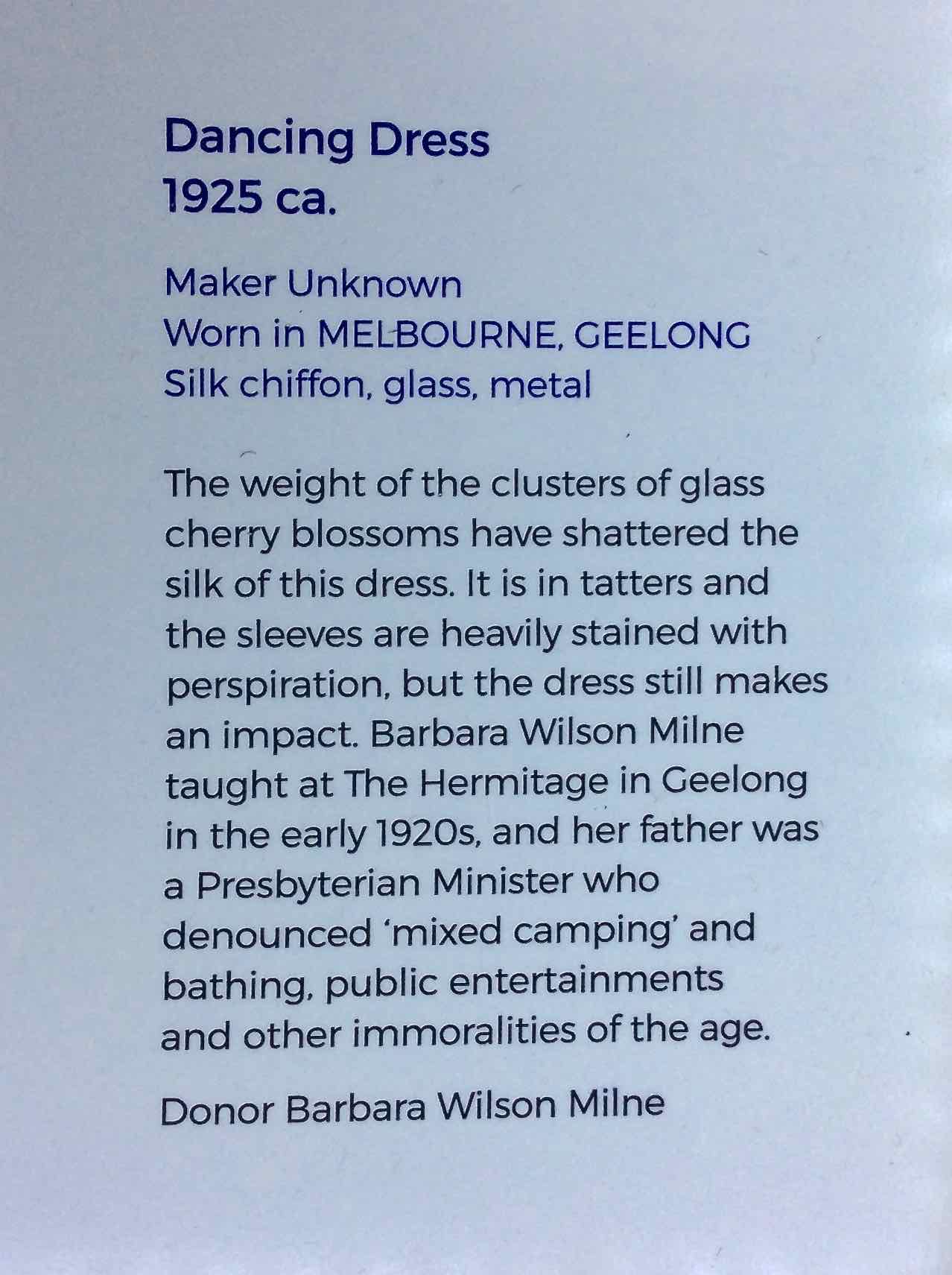
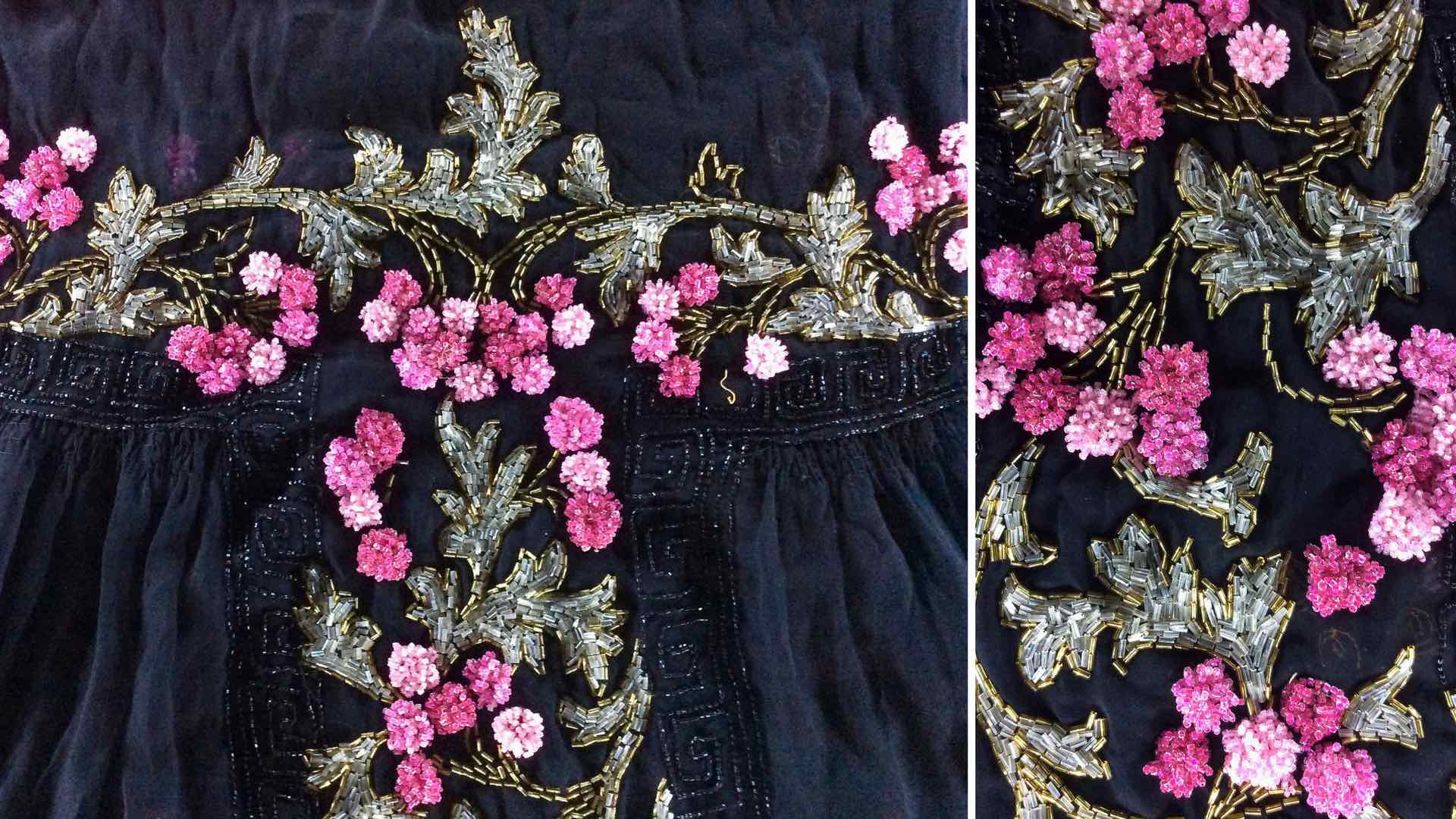
I am always struck by the wearability of these periods despite their difference. There are always elements that seem very contemporary. I was struck by the the simple, graphic beauty of this black, white and blue printed silk lining a simple black evening coat and the familiarity of the cloud shaped beading on a simple black dress.
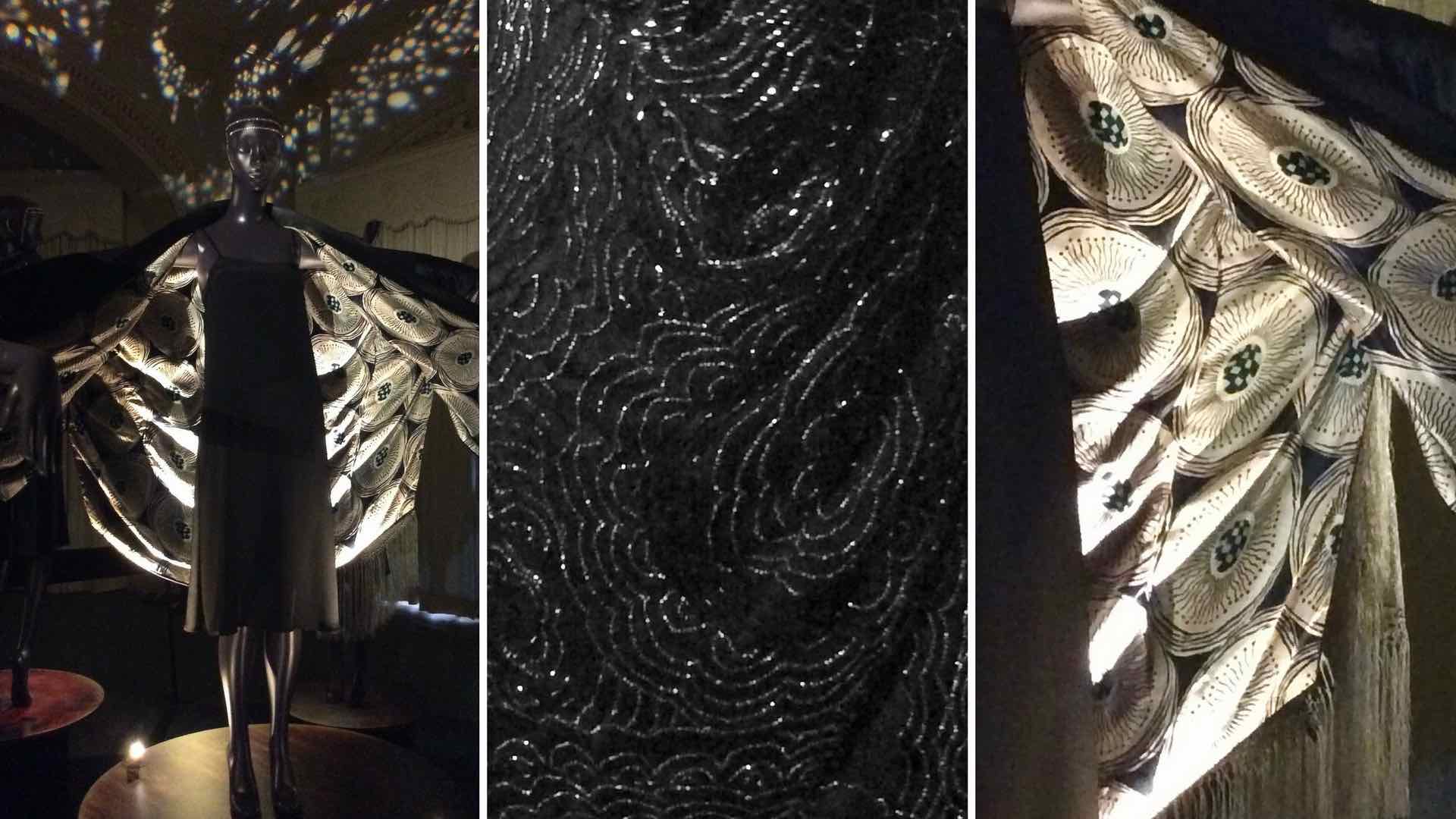
As I walk around the exhibition I can’t help but think of the many young women who would have spent hours stitching these intricate items with tiny tiny beads and sequins, and that is not even thinking about the tiny bits of tin so carefully wrapped onto mesh to create the Egyptian wrap! I have recently finished reading Fashion Victims and I can’t help but feel for their hunched shoulders, and strained eyes. I only hope that some of them had such slender hands and elongated fingers as those on the wearer of these gloves!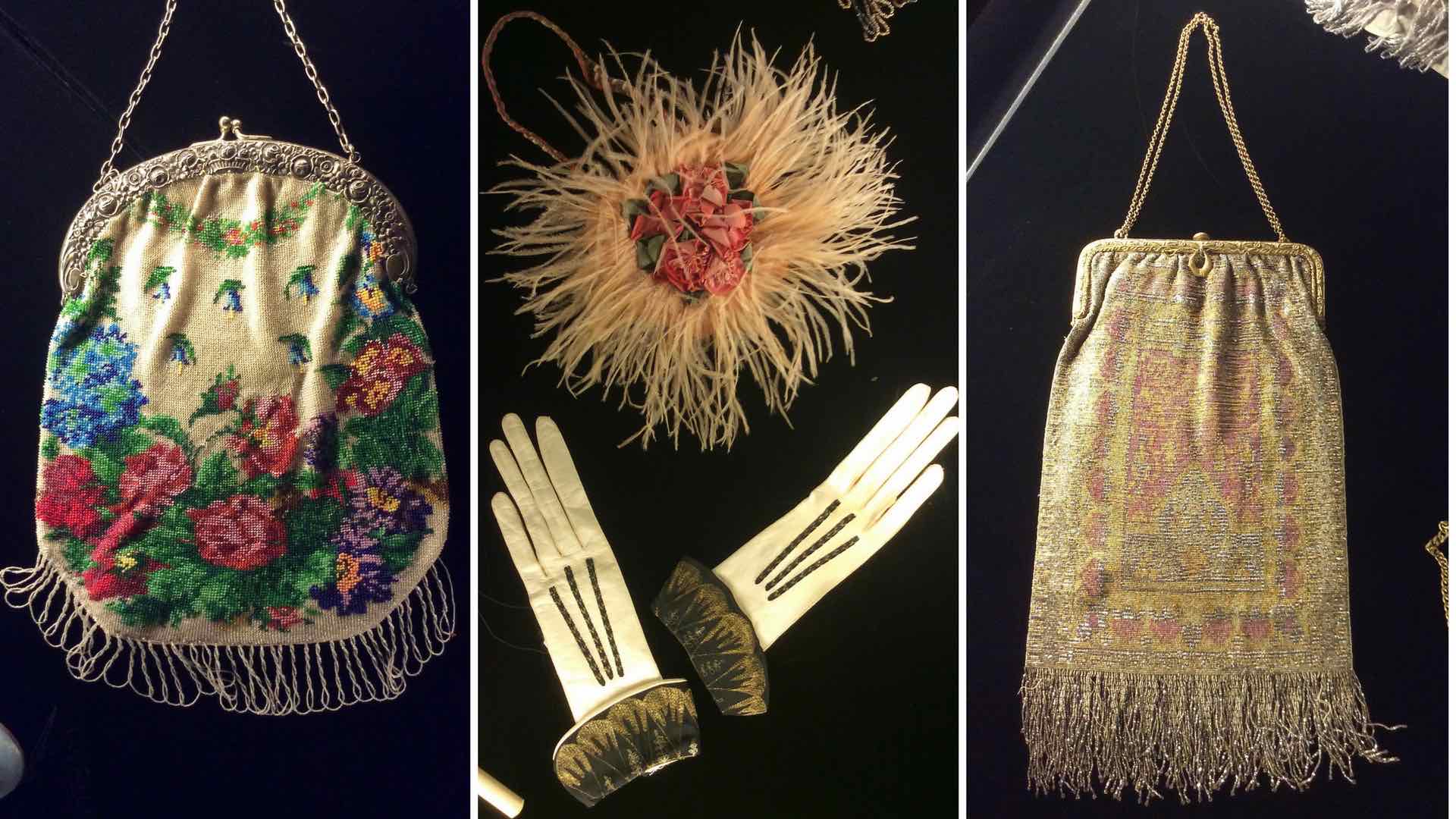
Art Deco influences are everywhere in beading and embroidery. This beaded shoulder detail struck me as quite unusual.
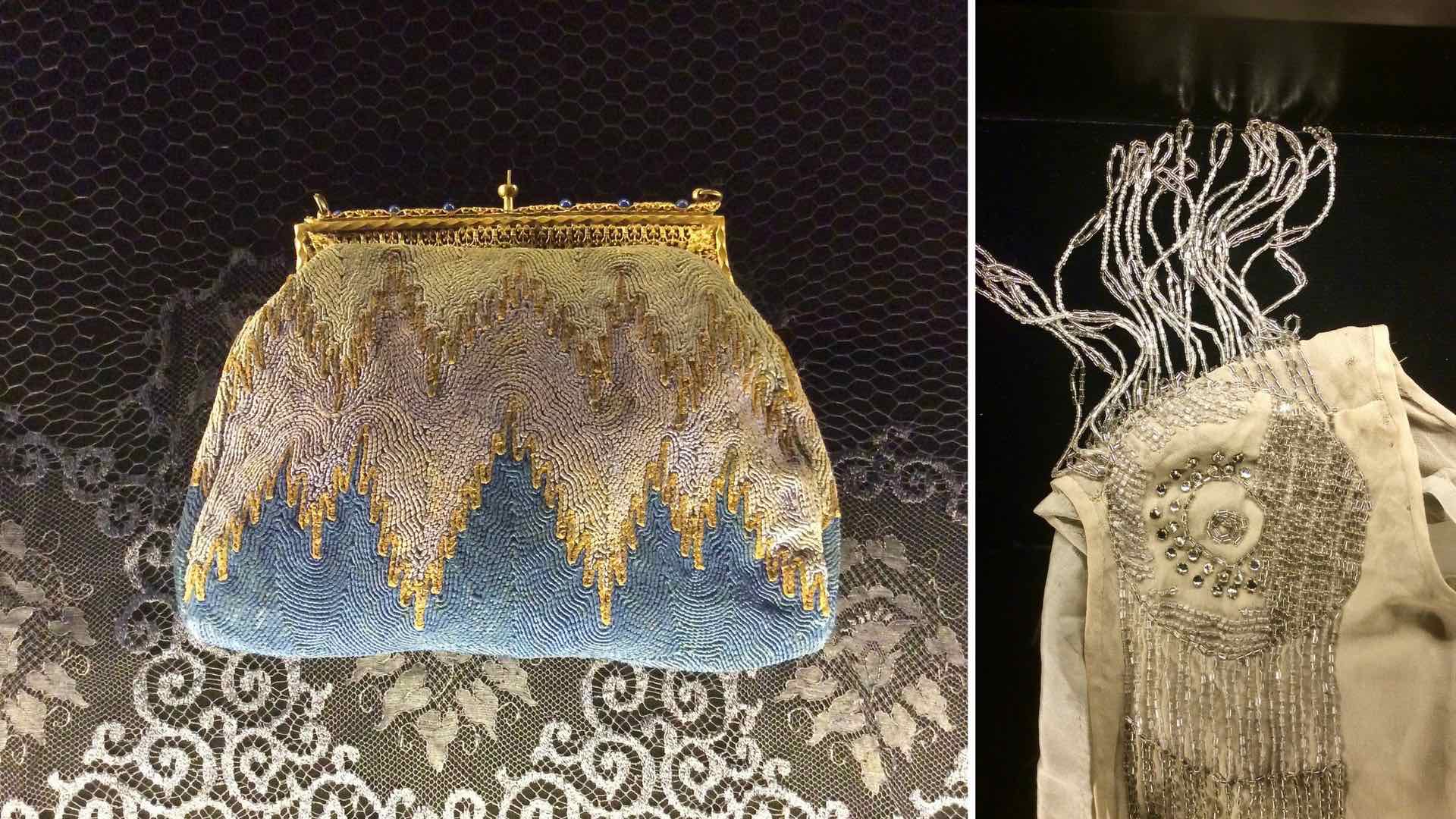
The richness of well lit black in velvet, lace, silhouette and some inspired lighting effects.
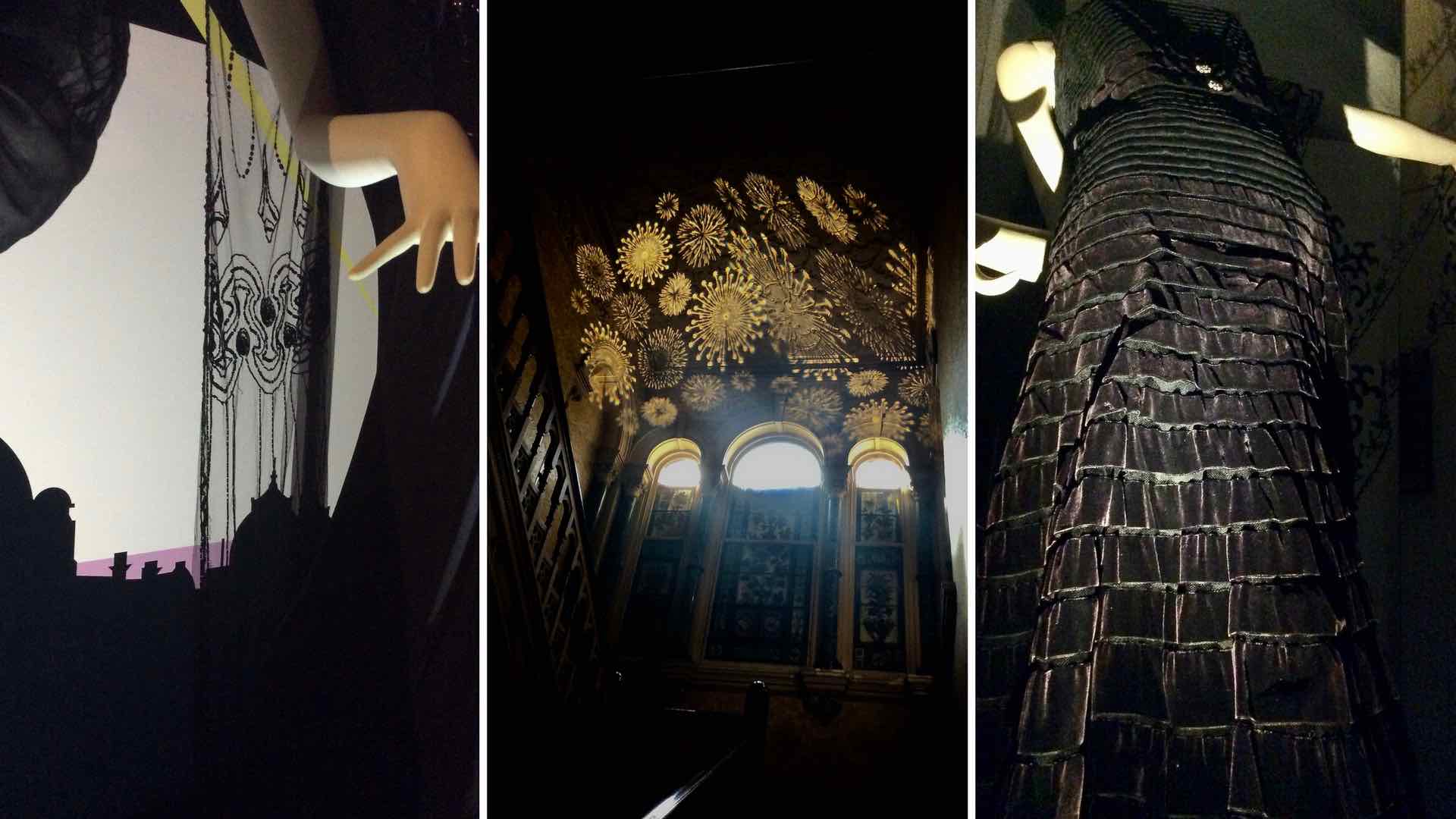
Shimmer and sparkle in celluloid, tin and gelatine. Just keep away from a naked flame as celluloid is highly flammable! It always make me smile when I think of all these women resplendent in celluloid and the connection with the importance and influence of the film era at this time. Women were watching and wearing the same material.
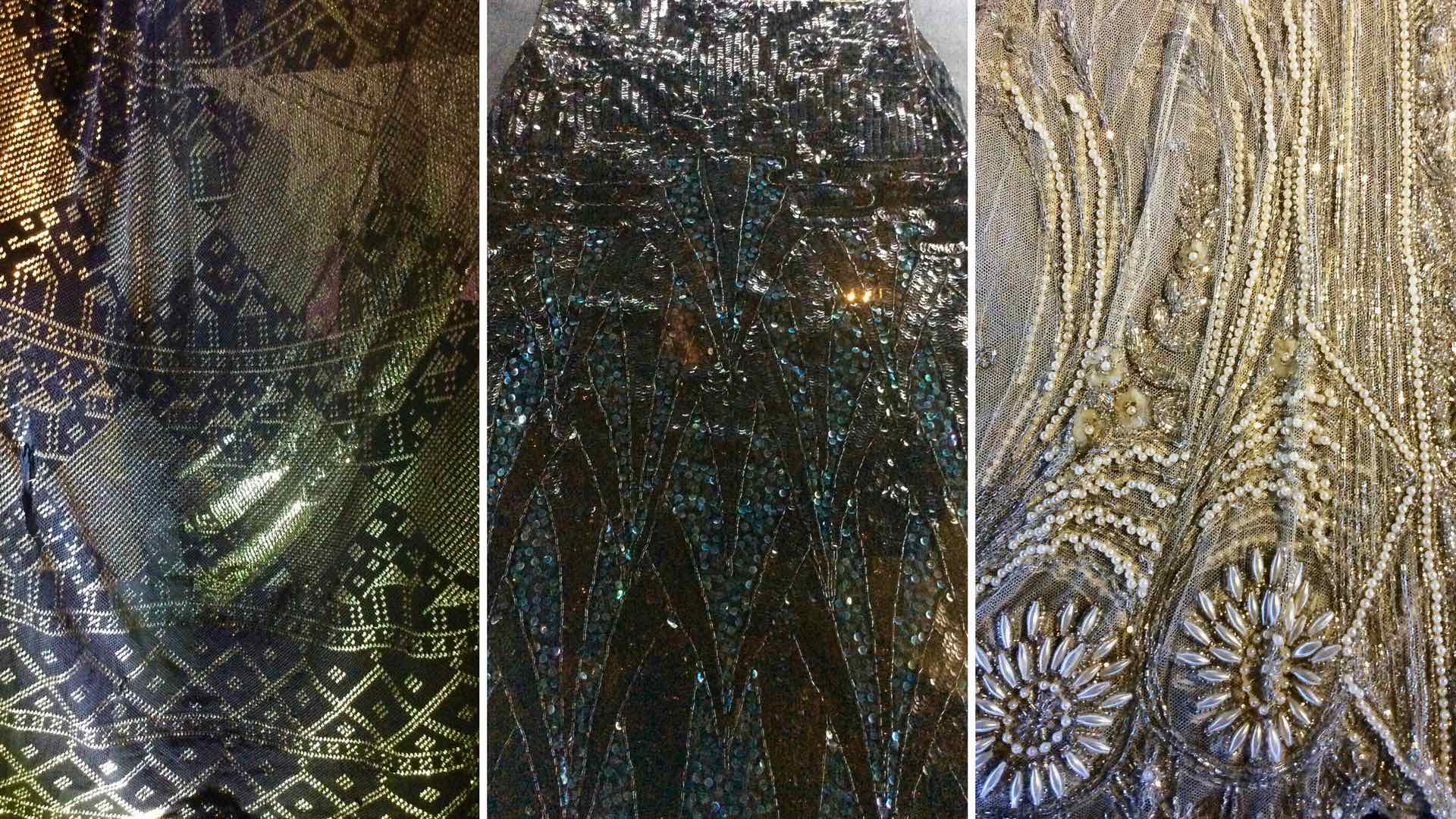
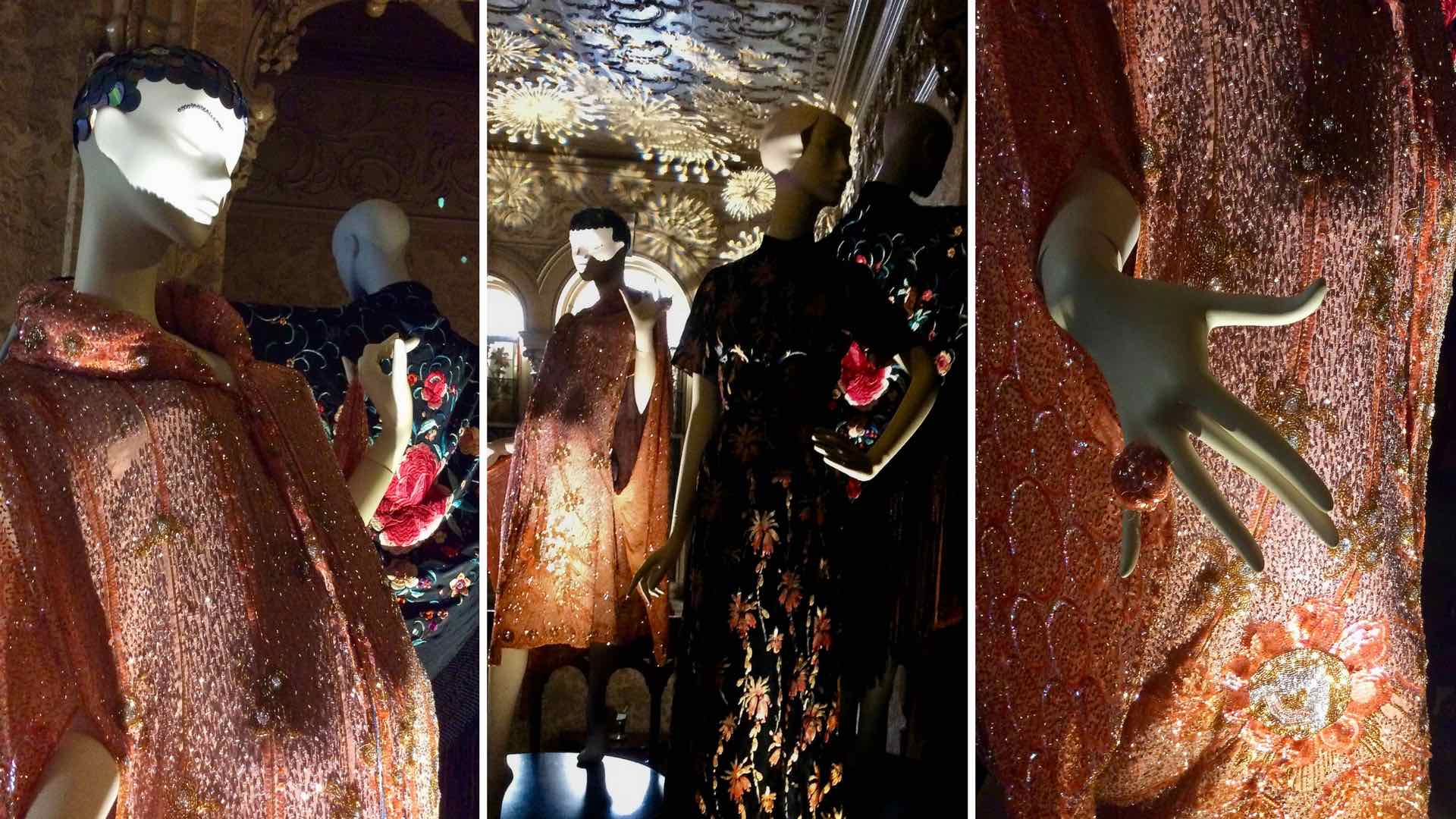
Floral motifs are ever popular but it interesting to observe the differences in the representation. Here you see them beaded in the 1920’s, painted and printed in the 30’s. 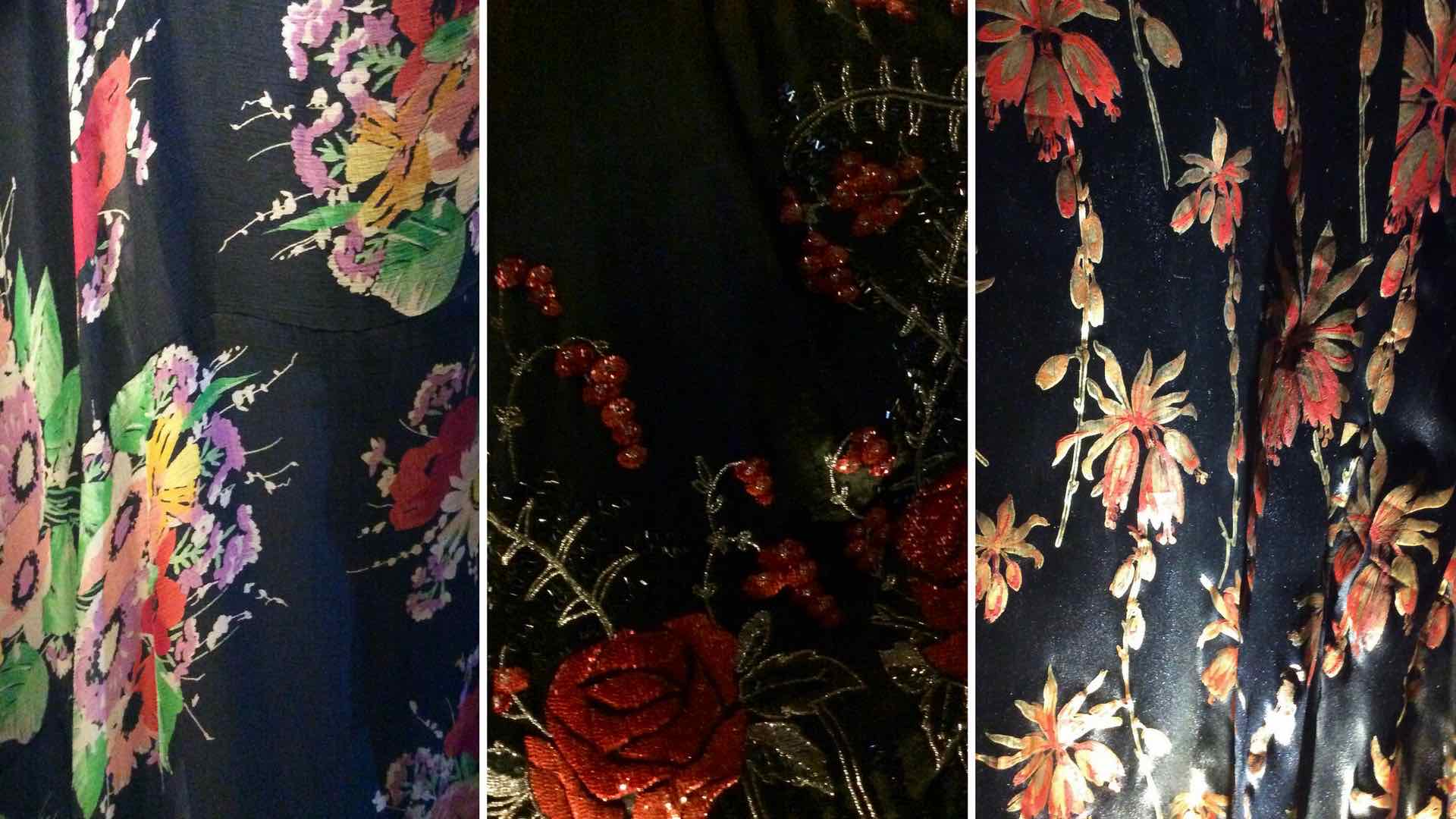
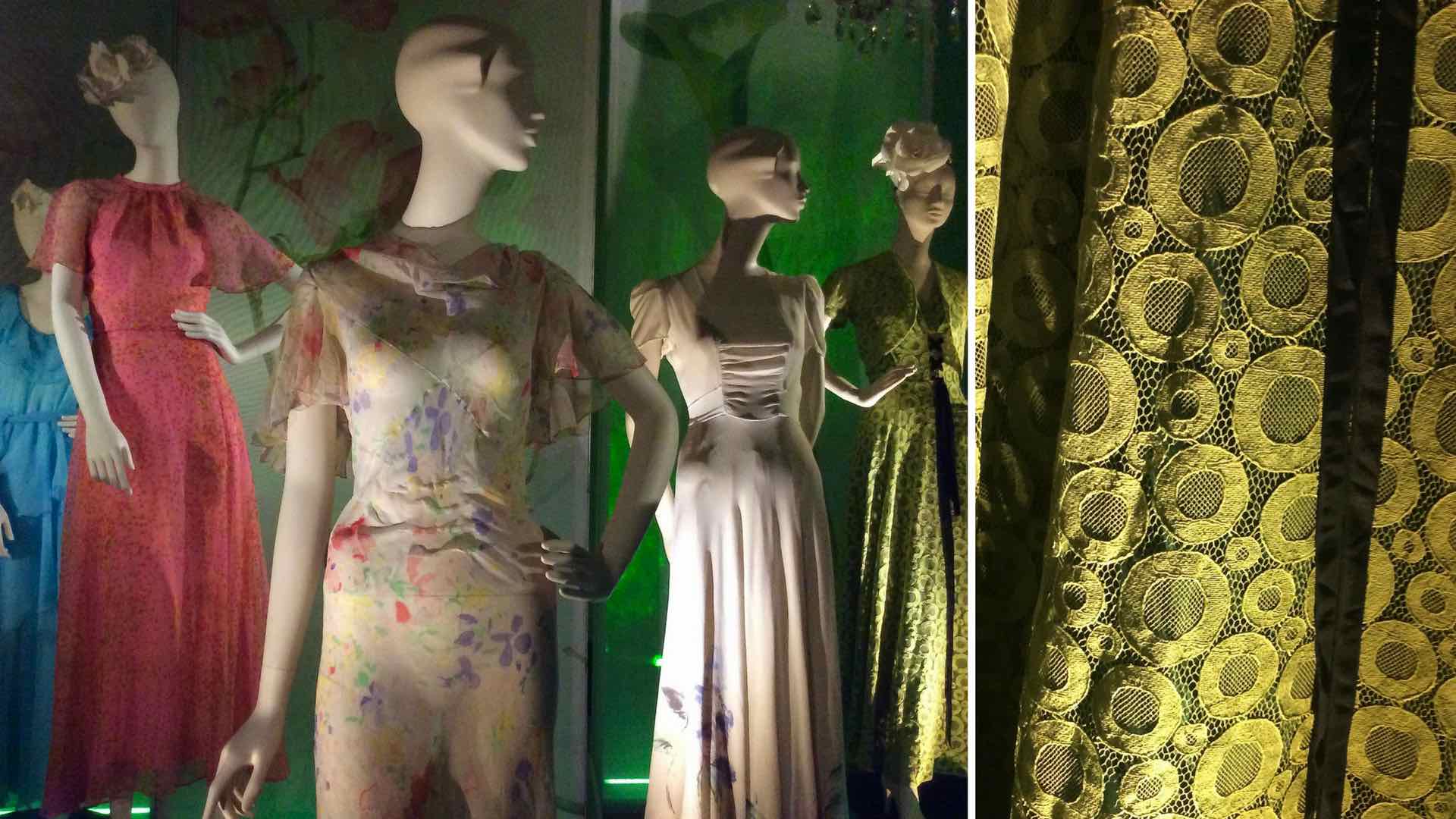
Embroidery and Asian influences in the 1920’s. These Chinese shawls were a popular choice to the warm exposed shoulders with flapper girls against chill.
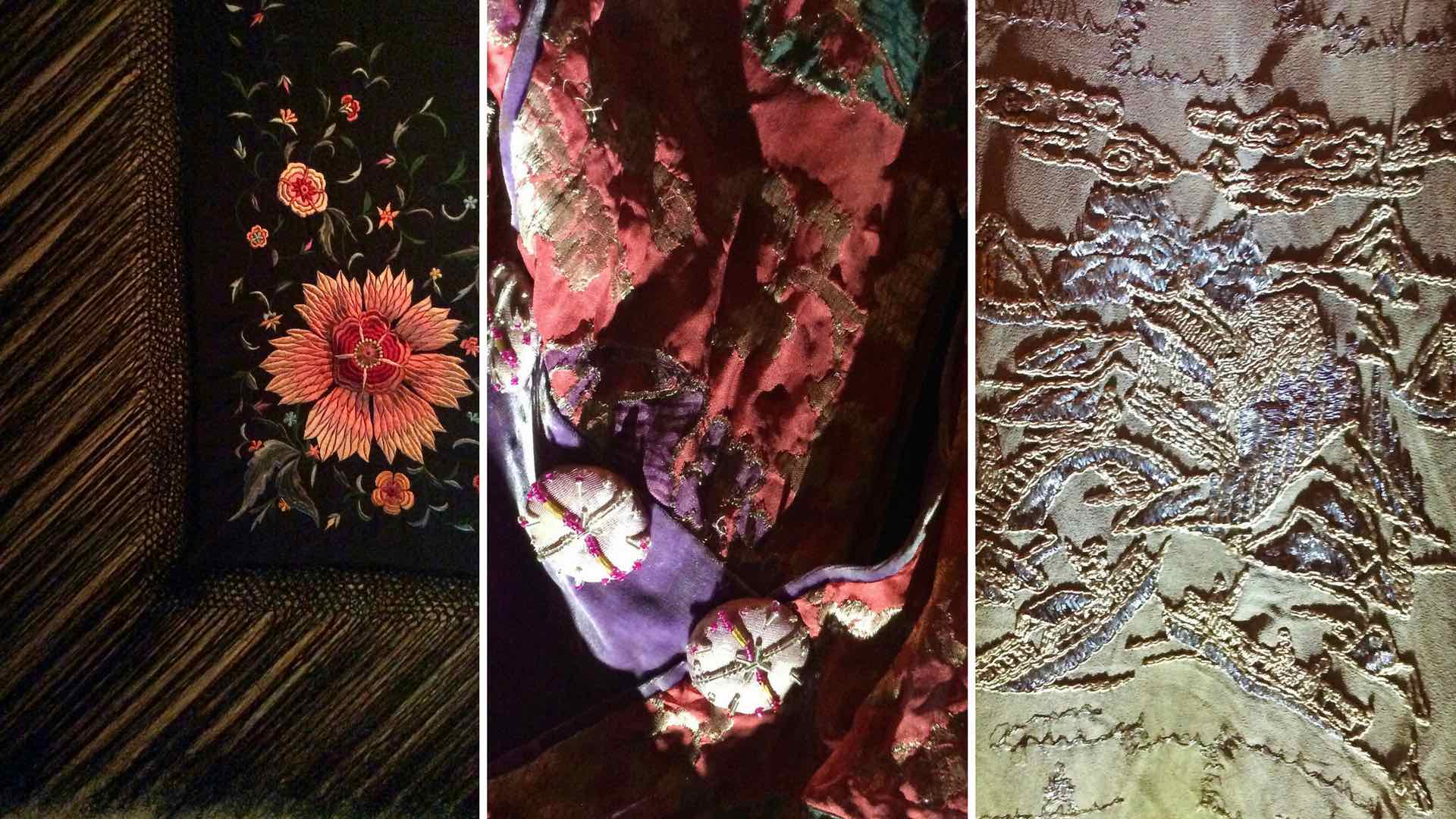
A visual feast, informative and a lovely day out in the gardens of Ripponlea.
But did you find the camels? Here they are, plus some Egyptian figures! Thanks to Erica Louise of recycled-fashion for her sharp eyes in spotting them and most of all for taking me as her “plus one”. Thanks also to the National Trust for another most enjoyable event.
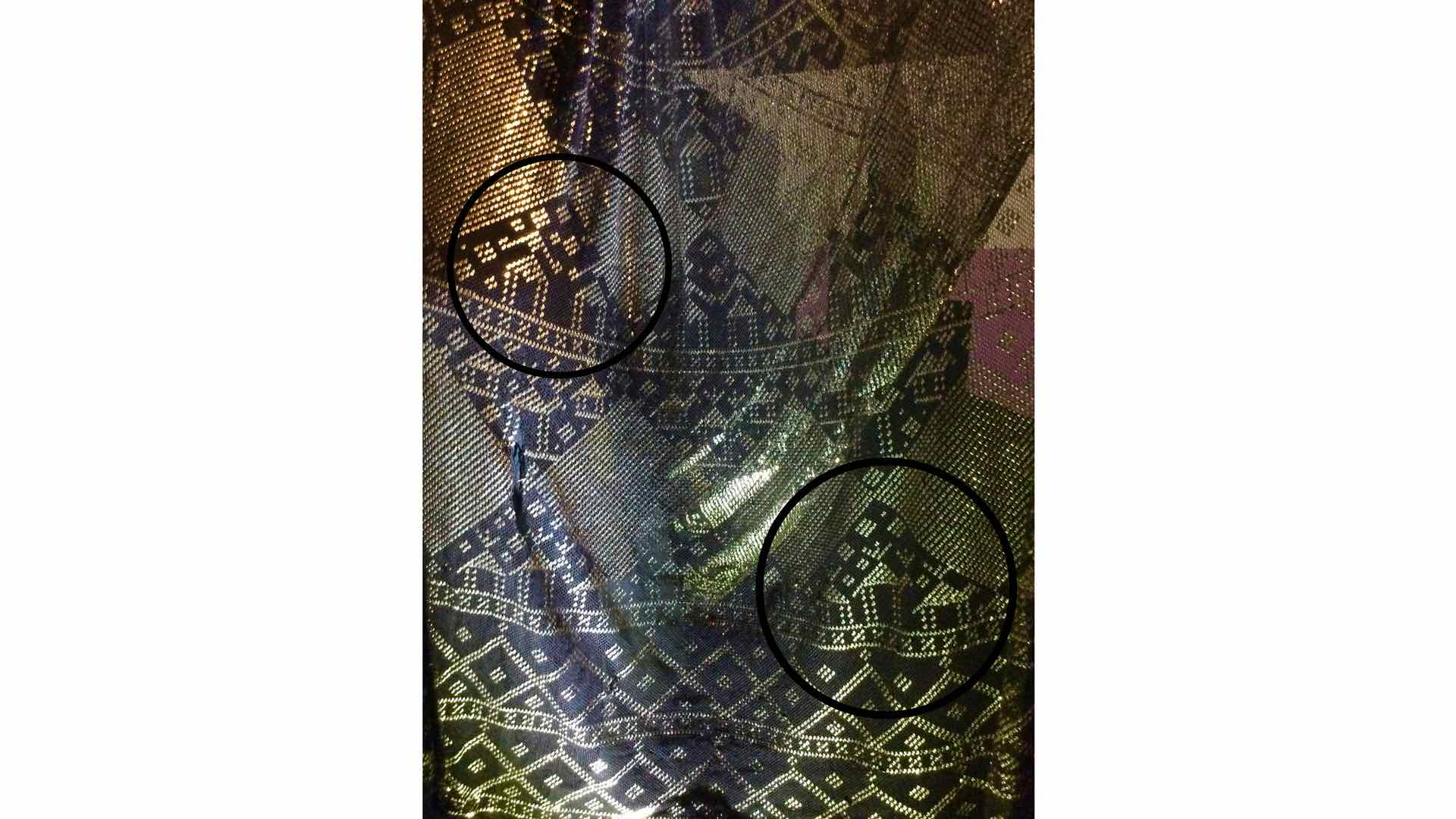
Enjoy!
Annabel
This lovely simple brooch was inherited from my late grand mother a few years ago. She was a woman of modest means but she loved to dress up when an occasion presented itself. Whilst this is a modest 1950’s piece I find it rather charming. When I received it was missing one diamanté with several more following in rapid succession. Hence it has been sitting in my mending box for many years. I recently have been working through my collection restoring and repairing pieces. The hardest thing about this job was sourcing the correct size Swarovski crystal is appropriate numbers. I am pleased with it, and am now looking for the right time to wear it. I do love vintage jewellery!
There is something special about family heirlooms that has nothing to do with monetary value. Somehow in knowing that one of your forbearers wore and valued an item of jewellery it gives you a connection to the past that is quite special. Jewellery is an especially personal item and pearls have been a valued commodity in fashion for many decades. My family were not wealthy and so Great Grandma’s pearls are quality faux pearls not real. Despite their faux status they are actually quite lovely as each pearl has an irregularity to its shape rather than being perfectly round. The pearls also have a creamy lustre with some depth not like modern fake pearls. They may be glass as they are quite heavy and tinkle loudly when dropped into a ceramic bowl.
When they were passed on to me by mother they were as she received them, broken, tied up in knots and fairly soiled. It’s hard to imagine how they came to be in this state. I know that she will have received them when her father died many, many years after the premature death of her mother. I can only imagine that he saw no value in them and they were in the back of a drawer or cupboard for many years since my Great Grandmothers death or at least Nanna’s death. I spent some time gently unraveling the strings before taking this first photo. You can see that the clasp and French wire are corroded and strings broken.
After counting and measuring I gave the pearls a gentle bath and the improvement in their lustre was quite heartening! Then began the restringing.
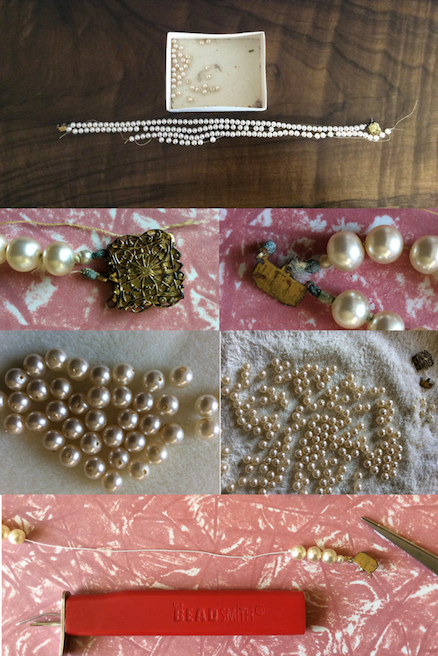
I had to work out the balance of the pearl numbers on each string to achieve the correct design and then restring with silk thread and French wire. Whilst these pearls were not originally individually knotted, as they are quite lovely and to improve their aesthetic I have chosen to restring them in the traditional manner with individual knots between each pearl.
Now I just have to have a think about how to rock three string pearls without actually looking like a Nanna!
I was really hoping my Aunt who is the keeper of old photographs in our family might be able to find a photo of Great Grandma in her pearls to accompany this post. Alas, none is to be found. Perhaps I should add a photo of one of my daughters wearing them in time. That would be fitting.
Cheerio,
Bella
I am ashamed to admit I bought this sweet little purse ages ago. No I really mean ages… I am pretty sure it was in the late 80’s early 90’s. It was in this state at the time and I bought it intending to refurbish its vintage goodness. Ah well, time has ticked on and it has never quite made it to the top of my priority list, until now. I am sooooooooo pleased though that I have finally had an excuse to put aside the time to attend to it. Finding beads wasn’t too difficult although I did have to compromise. I feel fairly certain the original bead was a size 10 and the closest I could get was size 11. The shape is also slightly different. The original bead is more like a doughnut where as the replacement is a bit fuller. I think it is ok though. It can now be used!
You can see that the old thread is slowly rotting away and this job required securing loose beads as well as rebuilding the original design as closely as I could ascertain from the barely visible stitching marks in the satin. It took a little time but I think well worth it.
After the beading and cleaning is finished, a very gentle manipulation and some steam to restore its original shape and voila, time to get out into society again.
Next project…..
Bella.
Brighton Historical Society at City of Glen Eira, Festival of Story Telling: Celebrating Style – 1950’s Fashion in Melbourne

Unfortunately by the time you are reading this, the exhibition will be over! Ah well. Due to other commitments both professional and personal I have not managed to get this post published in a timely manner. Never mind.
It was a lovely little exhibition held by the City of Glen Eira as part of their Story Telling Festival and I believe they were very happy with its patronage. The exhibition featured items from the collections of Nicole Jenkins of Circa Vintage, the National Gallery of Victoria, Diane Masters, Di Riedie of Brighton Historical Society and the Brighton Historical Society amongst others. I was very pleased to contribute to facilitating this arrangement on behalf of the Brighton Historical Society.
Diane Masters, a popular mannequin (model) of the day gave a lovely floor talk where she shared some of her very fond memories of the time. I was particularly struck by the stories she told of her good friend Hall Ludlow and the journey his life took from abandonment in an orphanage, through menial service jobs to creating his own fantastic career as a couturier. Over here you can read more from Diane Masters on Hall Ludlow.
Nicole Jenkins also spoke which reports tell me was also fascinating. Sadly I could not attend that event as I believe that Nicole is a veritable fountain of knowledge.
The following pieces were selected by the Glen Eira curator, Diane Soumilas, from the BHS collection for inclusion in the exhibition. With each piece I have included some notes and links that I have recently sourced, just the beginnings of research that might help anyone looking to learn more information about these labels.This collection is important to me as I am fascinated by the snapshot it provides of one particular community, as well as contributing to our broader social history in exhibitions such as this. It holds some interesting pieces which I hope to illustrate to you here. Further research is definitely required for full histories of items and makers.
A Colman Hat
A rather smart black raffia and diamante hat. Whilst the hat appears to be of Irish origin, as with all of our non provenanced items its presence in the collection suggests that it was owned and worn by a resident of the Brighton area.
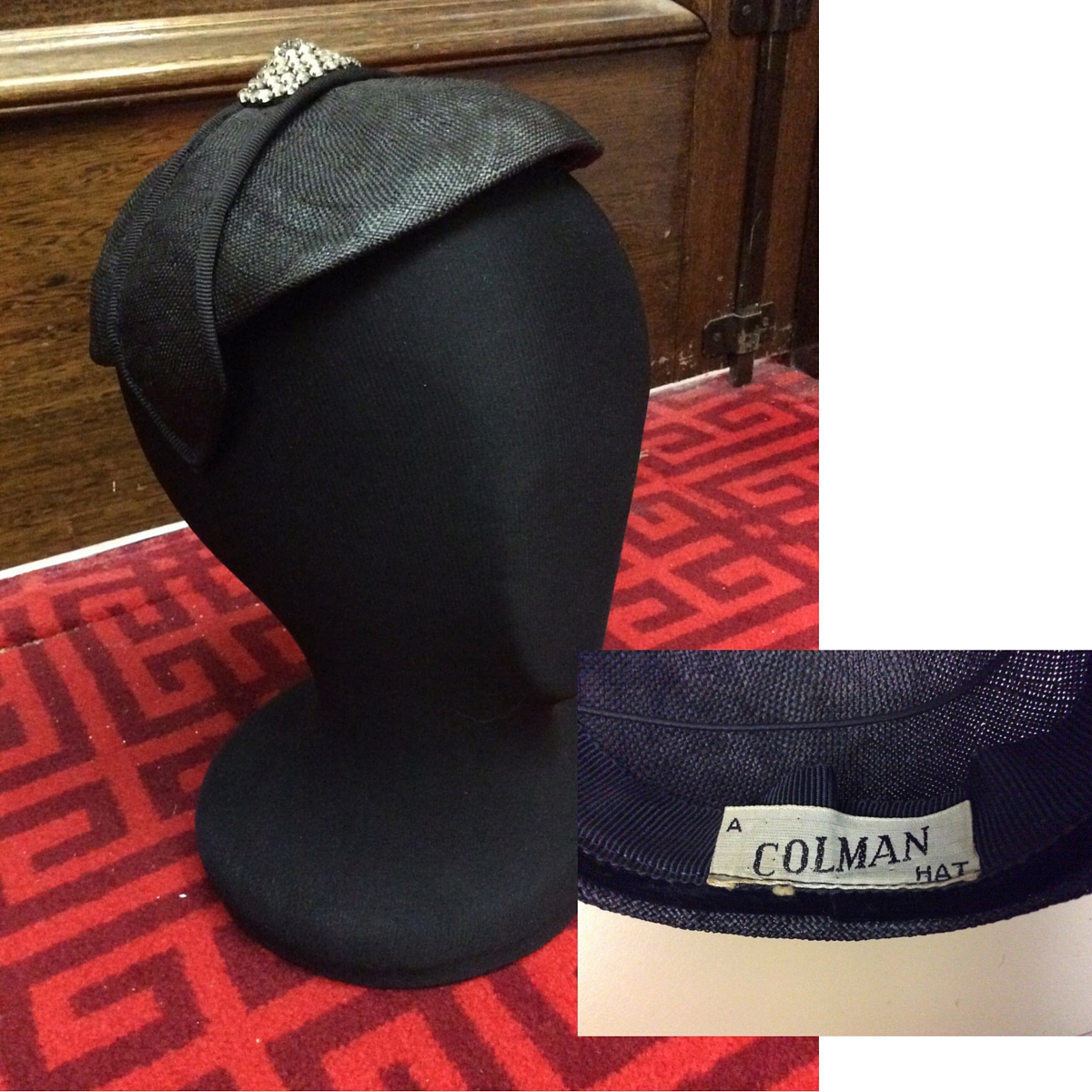
A Colman Hat – An item of unknown provence believed to have been made by Fisher’s of Cooktown, Northern Ireland.
With no real maker information to go on and judging purely by style I estimate this piece to have been made in the early 1950’s.
UPDATE: July 18th
I have been in at the society today putting away returns and in the process discovered two hats that have put a different perspective on things.
The way this hat is labelled indicates to me that potentially Colman hats may have been made especially for David Jones, Sydney for the local market. The first Colman hat may have similar provenance. Some unknown person has written 1960 and V. Vetra on the label which I suspect may have happened when it was initially donated to the society.
This hat has been labelled in a similar fashion. The only Horne I have found thus far is an American brand from the 1930’s in Pittsburg. I remain curious as to why this hat is labelled this way. Would love to hear from anyone who can fill me in further!
Harbig: Melbourne, New York, Paris
This sweet little floral piece is believed to have been made by Harbig Products of Melbourne. I have not yet unearthed any information to explain the use of the words New York and Paris on the label and would be fascinated to hear if more! Although I did find this news report
From The Sydney Morning Herald Thursday Sept 15 1949. page 7
that at least indicates that the Harbig’s were spending substantial amounts of time abroad. It is both head hugging and muted pastel and I therefore I feel we can safely date it to c1950.
 I also found these job advertisements for positions at Harbigs, which I find interesting. These professions exist these days in such a completely different manner. In the past you could make a career in a millinery factory in Melbourne. Today most milliners in Australia are skilled artisans working alone or in very small companies, often working across a variety of fields including teaching, fashion, and costume industries. My maternal grand mother was a milliner, finding these job advertisements has had me thinking about finding out more about her professional experiences.
I also found these job advertisements for positions at Harbigs, which I find interesting. These professions exist these days in such a completely different manner. In the past you could make a career in a millinery factory in Melbourne. Today most milliners in Australia are skilled artisans working alone or in very small companies, often working across a variety of fields including teaching, fashion, and costume industries. My maternal grand mother was a milliner, finding these job advertisements has had me thinking about finding out more about her professional experiences.
This ad from The Age July 5th 1961 advertisers for urgently required experienced milliners to do work from home.
In The Age Melbourne, Saturday June 22nd 1963 in the ‘millinery packing room’ at 1 Drill Street Hawthorn and Wednesday August 19th 1964 for “experienced, part experienced or learners, woman wanted for modern millinery department…an interesting and well paid trade’
Hicks Atkinson Melbourne
This dashing black silk velvet and straw hat is by Hicks Atkinson and Sons, Pty Ltd, Collins St, Melbourne. Hicks Atkinson Department Store operated from 1911 until 1963 and both retailed the designs of others as well as commissioning exclusive product. This store was in operation at the time when department stores were at the height of their popularity and this part of Melbourne was a shopping hub with a substantial number of luxury stores.
Judging by its style this piece is most likely to have been made in the early to mid 1950’s.
Mary H Thomas: Wattletree Rd East Malvern. Phone 505347
A silk velvet and net leaf hat. Unfortunately I have not been able thus far to find any further information regarding this milliner. My assumption is that she may have been a small artisan or couturier milliner, with a smaller less established business. I would love to hear from anyone who could offer me any information regarding her.

Mary H Thomas 103 Wattletree Rd. East Malvern phone 50 5347. An item of unknown provenance from the Brighton Historical Society Collection.
Nance Bannon
A frothy concoction of net, wire and paper featured above is a hat bearing the label Nance Bannon.
In my investigations online I have found a number of references to a society lady Miss Nance Bannon with dates in the mid 1930’s. One of these was on Trove, The National Library of Australia’s digital resource. Trove has a number of newspaper articles featuring promotions of Nance Bannon’s millinery from the newspapers similar to the ones I have linked to below. As yet I am not sure if this society lady in the mid 1930’s is the same Nance Bannon as the 1950’s and on milliner but it seems likely. Miss Nance Bannon is third from the left in the central photograph.

Table Talk Newspaper (Melbourne Victoria 1885 – 1839) Nance Bannon The Birdcage Aug 1st 1935 ‘Out at Moonee Valley’ Click the image to go through to the item on Trove.
Trove has numerous 1950’s digitised newspapers featuring ‘advertorial’ for Nance Bannon and her millinery. Articles from both South Australian and Victorian newspapers are featured. It would appear that whilst she was based in Melbourne she may have regularly travelled to Adelaide to show her wares.
Over here you can find two ads from The Age Melbourne Saturday Jan 14 1956 in which Nance Bannon advertises millinery positions: .
Milliner, exp.. model work. Nance Bannon, 174 Collins sc.
“TVfILLINERY, ‘improvers and AP-iTX prentee, Nance Bannon, 174 UQ1IUU bl
This second job description seems quite baffling! I suspect the ad is supposed to read “millinery improvers and apprentice”?
These ads indicate that in 1956 Nance Bannon appears to have been located at 174 Collins St Melbourne.
In this Age newspaper story in 1961 featuring three Autumn / Winter collection hats and again in this story in 1966, in The Age newspaper that features from August 3rd 1966 of four hats from Nance Bannon’s spring collection indicates that she is now located in South Yarra .
In this Age newspaper story from August 9th 1967 we see Nance Bannon featured again (my, she was popular).
From looking at the styles of these hats, the dates of her work, and her business address I estimate this hat to be c 1956 – 1961.
Misses Mooney
An aqua blue rayon wrapped ribbon turban from the late 1950’s. However, it is of note that the label on the hat looks more modern than the label on the dress. Hence the hat even date into the early 60’s. Please note the colour in the label image is more accurate.
The fashion label Misses Mooney was operated by two sisters from the premises at 189 Collins Street Melbourne. The label was established in 1932 and closed in 1972. It is unclear if it operated from this address for the entire time. There is little information available regarding this label, although at that time this part of Collins Street held a thriving industry of dressmakers and associated trades. The Powerhouse Museum in Sydney holds a Misses Mooney ensemble with some useful contextual information here.
The Brighton Historical Society has a former volunteer who once worked for Misses Mooney who provided an oral history she called ‘Memories of Another Era’. This oral history can be accessed by contacting Brighton Historical Society.
The following are some points of interest from her history from her time working for the Mooney’s c1944 – 46.
- The business Misses Mooney was owned by two sisters Nell and Ida Mooney, situated in a very narrow shop front beside The Regent Theatre in Collins Street Melbourne and open five and a half days per week.
- Above the shop on the first floor worked four seamstresses plus a supervisor Miss Foulds in cramped conditions.
- Miss Foulds also attended to the fittings of garments with clients and any alterations when necessary.
- Further up Collins St in a seperate building on the third floor and in cramped workroom conditions were three machinists who made garments for special clients. Wages were approx. 2 pounds for a 40 hour week.
- This lady recalls working 44hr days with Ida. Work began at 8am until 5 pm with 1/2 hour for lunch.
- Close to this workroom was a milliner Dorothy Gringod, a “sprightly, friendly lady” who created the headwear and supplied the Mooney’s shop with some of her creations. Dorothy would make headwear for the girls from Miss Mooney’s at half price when they needed something for an event.
- This lady recalls seeing Japanese prisoners of war being driven up Collins St past the store as she was out getting lunches.
Brighton also holds a beautiful 1950’s Misses Mooney dress not featured in this exhibition
Raoul Couture Dress
A stunning cream silk and lace creation of pleating, ruching and delicate construction this Raoul couture dress is just lovely, and rather tiny. Raoul couture was a highly respected fashion house based in Flinders Lane, Melbourne from c 1955 until 1963. Head designer Leonard Legge later worked for another prominent Australian designer Prue Acton.
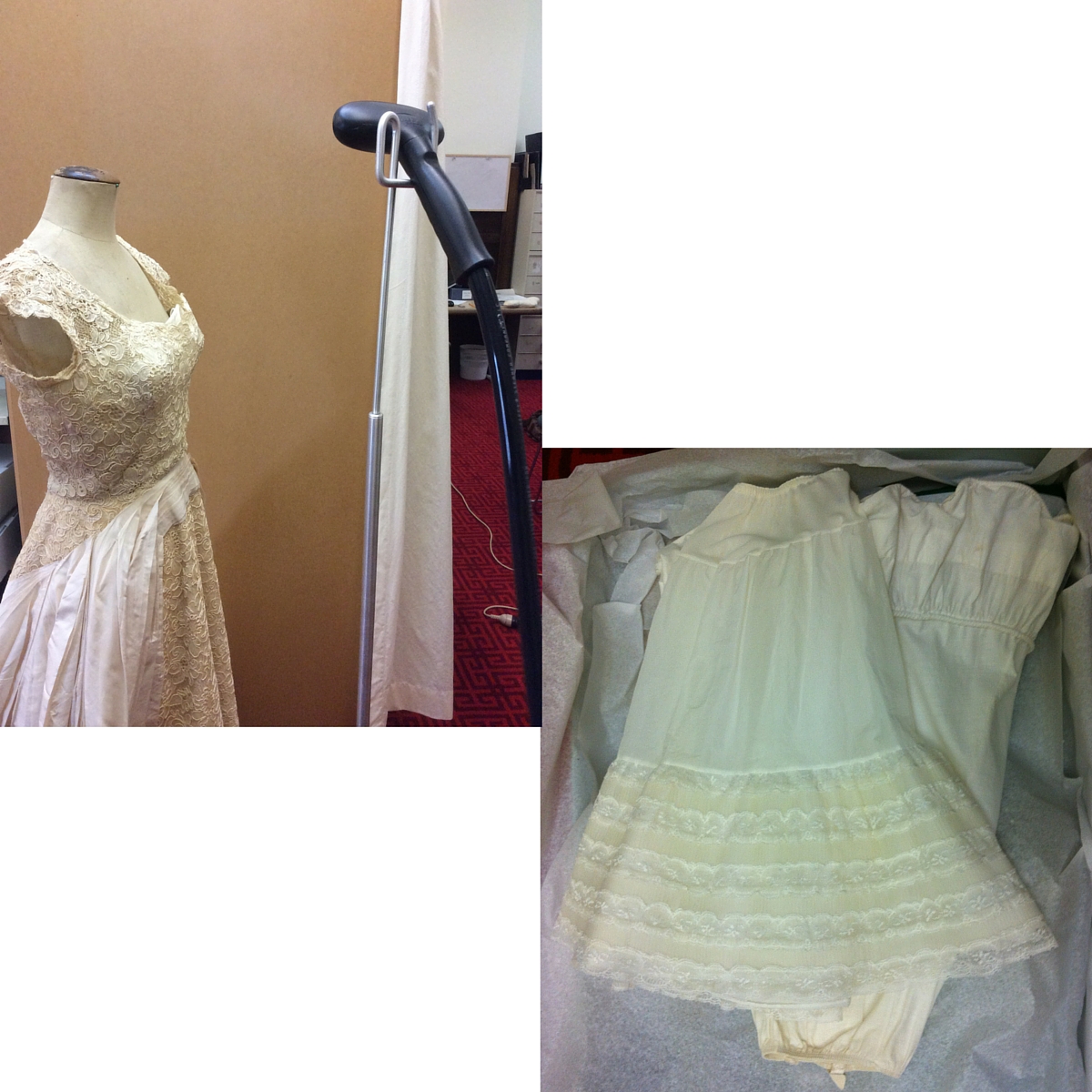
Very carefully steaming the Raoul Couture dress prior to transportation. It will require further attention prior to dressing the mannequin. Three vintage petticoats for layering under the dress.
Till next time….
Cheerio!





